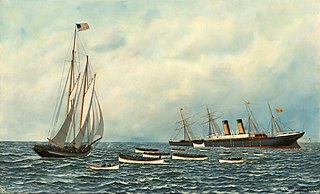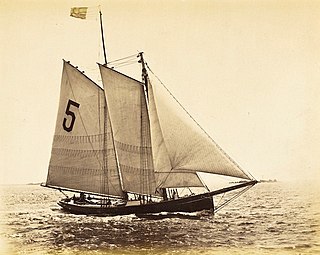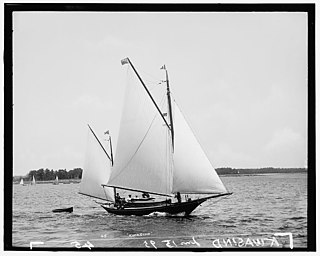
Pet No. 9 was a pilot boat used by the New York Sandy Hook Pilots in the 19th century. The schooner was used to pilot vessels to and from the Port of New York and New Jersey.

C. & R. Poillon was a 19th century shipyard company in Brooklyn, New York. The company employed over 300 workers, owned several shipyards, and launched 175 vessels. The company was one of the best known clipper ship firms and the last of the wooden hulled boat builders in New York.

The Sylph was a 19th-century pilot boat first built in 1834, by Whitmore & Holbrook for John Perkins Cushing as a Boston yacht and pilot-boat for merchant and ship owner Robert Bennet Forbes. She won the first recorded American yacht race in 1835. She was a pilot boat in the Boston Harbor in 1836 and 1837 and sold to the New York and Sandy Hook Pilots in October 1837. She was lost in winter of 1857 with all hands during a blizzard off Barnegat, New Jersey. The second Sylph was built in 1865 from a half-model by Dennison J. Lawlor. The third Sylph was built in 1878 at North Weymouth, Massachusetts for Boston Pilots. She was sold out of service in 1901, after 23 years of Boston pilot service.

James H. Reid, was a 19th-century American Maritime pilot. He is best known for being the dean of the Boston pilots, serving for 55 years. He was captain of the famous yacht America for 17 years when she was owned by Benjamin F. Butler. In 1897, he built a new America, named after the America's Cup defender.

The Phantom was a 19th-century Sandy Hook pilot boat built in 1867 from the designs by Dennison J. Lawlor. The schooner was considered a model for her type with a reputation for being very fast. She helped rescue the passengers on the steamship SS Oregon when it sank in 1886. She was one of the pilot-boats that was lost in the Great Blizzard of 1888. The Phantom was replaced by the pilot-boat William H. Bateman.

The D. J. Lawlor was a 19th-century Boston pilot boat built in 1881 at North Weymouth, Massachusetts. The schooner was considered the largest for her type, noted for her seaworthiness and heavy weather performance. She was named after the prominent Boston shipbuilder Dennison J. Lawlor. She was struck by a fishing schooner Horace B. Parker, in 1895, and was replaced by the pilot-boat Liberty in 1896.

The Hesper was a 19th-century Boston pilot boat built in 1884, designed from a model by Dennison J. Lawlor as a Boston yacht and pilot-boat for merchant and ship owner George W. Lawler. She was known to be the largest pilot boat under the American flag at 104 feet long and the fastest of the Boston fleet. She competed in several first-class sailing races, and in 1886, the Hesper won the silver cup in what was known as the first Fishermen's Race. She was withdrawn from the pilot service and sold in 1901. The Hesper became a wreck on the point off Cape Henlopen in 1919.

The Northern Light was a 19th-century yacht, built in 1839 at the Whitemore & Holbrook shipyard for Colonel William P. Winchester, a Boston merchant. She was designed by Louis Winde, an early yacht designer and shipbuilder. She sank en route to California in 1850. A second Northern Light, was built in 1927 and bought by the Boston Pilots' Association to serve as a pilot-boat from 1934 to 1941. She was sold to the United States Army in 1941 to serve in the war effort during World War II.

William C. Fowler, was a 19th-century American Boston maritime pilot. He is best known for being the oldest pilot in the pilot service having served for fifty years as a branch pilot. He was captain and owner of the pilot boat Florence. His nephew, Franklin Fowler was a well known Boston pilot.

The Friend was a 19th-century pilot boat built by Daniel D. Kelley & Holmes East Boston shipyard in 1848 for Boston pilots. She helped transport Boston maritime pilots between inbound or outbound ships coming into the Boston Harbor. The Friend was one of the last of the low sided, straight sheared schooners built in the 1840s for Boston pilots. The second Boston pilot boat Friend was built in 1887. Her name came from the older Friend that was in the service in the late 1840s. Captain Thomas Cooper sold the Friend to New York pilots in 1893. Cooper replaced the Friend with the pilot-boat Columbia in 1894.

David Carll was a 19th-century American shipbuilder. He was well known for building fast and seaworthy yachts and schooners. He specialized in shallow draft Centreboard schooners. The David Carll's shipyard was the first commercial shipyard built in City Island. He built the popular schooners David Carll, Vesta,Resolute, and Ambassadress. His brother, Jesse Carll had a successful shipyard in Northport, New York.

The Mary E. Fish was a 19th-century Sandy Hook pilot boat, built at the Edward F. Williams shipyard of Greenpoint, Brooklyn in 1861 for Richard Brown and the New York Pilots. She was built to replace the Mary Taylor. The Fish was hit and sank by the schooner Frank Harrington in 1885 and replaced by the David Carll.
Dennison J. Lawlor, was a 19th-century Canadian-Irish shipbuilder and yacht designer. He apprenticed under shipbuilder Whitmore & Holbrook. Lawlor had his own shipyard, building and designing for 40 years some of the finest yachts, pilot boats, and 150 merchant vessels built from his designs. The most notable were the Hesper, Florence, and D. J. Lawlor. Lawlor died in Chelsea, Massachusetts in 1892.

The Fleur de Lis was a 19th-century yacht and pilot boat built in 1865 by J. B. Van Deusen for Captain John S. Dickerson of the New York Yacht Club. She was bought by pilot Franklin B. Wellock and became the Boston pilot boat No. 7. She was known as one of the best pilot boats in the Boston harbor. By 1904, the pilot boat Fleur de Lis was lying in a graveyard for old boats in East Boston.
Ambrose A. Martin, was a 19th-century Boston, Massachusetts yacht and boat shipbuilder. He built the Ambrose A. Martin shipyard in 1882 at Jeffries Point, East Boston, where he built many notable Boston yachts and schooners. Martin died in Boston in 1934.

Edward A. Costigan, was a 19th-century Boston, Massachusetts shipbuilder. In 1858, he founded the E. A. Costigan shipyard at Commercial Street in Boston, where he built many notable pilot boats and scows. He was one of the oldest of Boston shipbuilders, being connected with shipbuilding most of his life. Costigan died in Boston in 1901.

Gracie was a 19th-century Boston pilot boat built in 1869 at the Edward A. Costigan shipyard in Charlestown, Massachusetts. The schooner was used by Boston pilots and was sold to North Carolina pilots in 1881.

Elbridge T. Gerry was a 19th-century New York Sandy Hook pilot boat built in 1888 at the Robinson & Waterhouse shipyard in City Island, Bronx. She was named in honor of Elbridge Thomas Gerry, a commodore of the New York Yacht Club. She served as a pilot boat from 1888 to 1896, when she was sold for offshore yachting cruises. Her name was changed to Kwasind, after the strongman in Henry Wadsworth Longfellow's Song of Hiawatha.

The William Starkey was a 19th-century pilot boat built in 1854, by Benjamin F. Delano at the Thatcher Magoun shipyard for W. W. Goddard, of Boston. Starkey helped transport Boston maritime pilots between inbound or outbound ships coming into the Boston Harbor. She was named for Captain William Starkey, one of the founders of the Boston Marine Society. The Virginia Pilots' Association purchased the Boston schooner William Starkey in 1865, where she became a pioneer of the associations' fleet and the oldest pilot boat on the Atlantic and Gulf coasts. In the age steam, she was sold in 1899 to Thomas Darling of Hampton, Virginia.

















